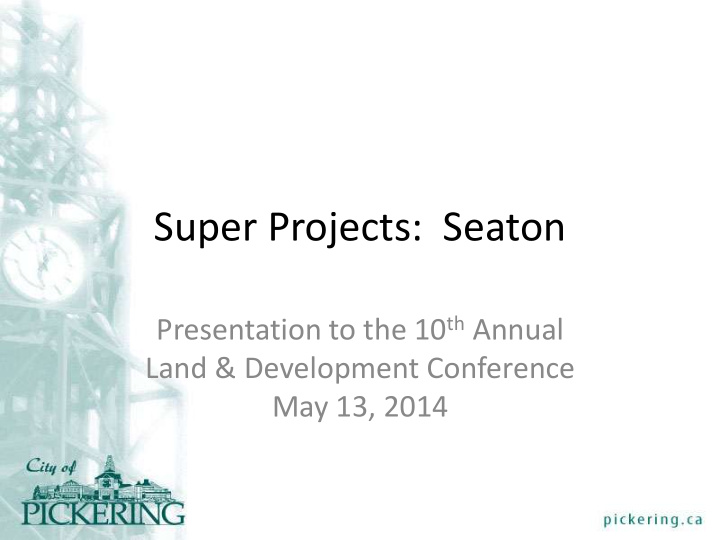



Super Projects: Seaton Presentation to the 10 th Annual Land & Development Conference May 13, 2014
Overview of Presentation Land & Development Conference, May 13, 2014 • The who, what, where, when, why and how of Seaton • Municipal objectives • Challenges ahead • Moving forward • Lessons learned
Central Pickering Development Plan The Vision: “a sustainable urban community in Seaton with a thriving agricultural community in the Duffins Rouge Agricultural Preserve and an extensive Natural Heritage System”
Fun Facts 1,570 ha natural heritage system 400 ha employment lands 1,247 ha mixed use and residential 23,000 households; density: 40% low; 40% medium 2031 = 61,000 residents and 30,500 jobs (2:1) 26 km of Regional Roads (Type A & B Arterial) 20 km of Type C Arterials and collectors 105 km of local subdivision roads 151 km total
More Fun Facts Sanitary Sewer System $85,000,000 Water Distribution System $163,400,000 Regional Roads $248,094,000 Total $498,000,000 17 School Sites City Facilities: District Park, 2 Fire Halls; 2 Recreation Complexes with Libraries; satellite Operations Centre; 60+ stormwater ponds Regional Facilities: EMS, Police Station, Transit Depot, Works Yard, Waste Transfer Station
Municipal Objectives 1. To achieve sustainable development (a model community that is compact, walkable, transit oriented, mixed use, environmentally responsible) 2. To ensure jobs are developed with residential 3. To obtain land from the Province for a District Park 4. To ensure the development of Seaton does not have an undue fiscal burden on the City re the supply of City services and facilities 5. To have community facilities available coincident with residential development 6. To reduce the footprint of public sector land needs
Challenges Ahead • Sustainable Development • Create jobs at the same time residential • Land for City uses (District Park) • Land for places of religious worship • Legacy costs for stormwater infrastructure • Adequacy of transit services • Construction of primary trails
Moving Forward • Provincial Treasury Board approval • Financial Impacts Agreement execution • Marketing of Employment Lands • Regional Environmental Assessment for Infrastructure • Front-funding Agreements • Design and construction of trunk sewers • Fulfilling subdivsion conditions of approval • Site grading, servicing, construction • Ministry and agency permits and approvals • Monitoring impacts on transportation system
Lessons Learned – Some of the most important decisions that people make are the first ones – Need integrated decision making with all the necessary stakeholders – Expect delays and surprises
Thank you Catherine Rose, MCIP, RPP Chief Planner, City of Pickering
Recommend
More recommend